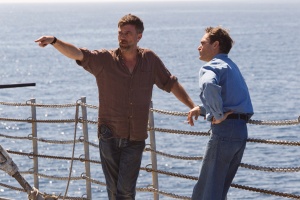Venice was founded by refugees fleeing the Germanic tribe, the Lombards, after they invaded Italy in 568 AD. The refugees came from the town of Aquileia, traditionally believed to have been founded by St. Mark. At that time the Christian Byzantine empire spread across that area of Italy, and the islands that make up Venice were part of a defensive agreement between the Byzantine’s and the Lombard’s, and came under Byzantine control. However, as the Byzantine empire’s grip of power in the west loosened, the early Venetians found themselves largely independent. Through their skills as merchants they grew in power and wealth, and by 726 they elected their first Doge (like a Duke). The first Doge, failed in his attempt to become independent from the Byzantines.
Through time the Venetian’s ruthless diplomacy and ability to play one power against another eventually secured her independence; and Venice’s excellent location between the powers of western Europe and the east gave her the opportunity to grow increasingly wealthy via trade, and became a popular navigational route to the eastern countries from Europe.
In the early 9th century, Venice needed to improve her status, and in the Christian Middle Ages, that required a patron saint and relics. Since Venice was founded by the refugees of Aquileia they adopted St. Mark as their Saint. Legend has it that two Venetian merchants stole St. Mark’s body from a tomb in Alexandria and brought his remains back to the Basilica in Venice. Throughout the city there are depictions of winged lions, symbols of St. Mark.
In the 11th century the power of the Norman invasion in Europe threatened the Byzantines in Italy. The Venetians agreed to help the Byzantines against the Normans. In return for their help the Byzantines allowed the Venetians to trade freely with them, and not pay the same duties and customs as other nations. The start of the Crusades began to open up trading routes with the east, which Venice was uniquely placed to exploit.
However, by the 12 century the pride and wealth of the Venetians bred hostility in Constantinople (the centre of the Byzantine empire). As a result the Byzantines made new trade deals with Pisa and Genoa and they began to tax Venetian traders. Hostility between the old allies grew.
With internal power struggles in the Byzantine empire and the Fourth Crusade looming, Venice had a chance of revenge. The Catholic Church looked for financial support in the launching of a new crusade- this time against wealthily Egypt and Cairo. The Venetians offered their military support and use of their naval power and infrastructure; in return for half of any lands conquered and 85,000 silver marks. The church agreed and the fleet was due to depart June 1202. However, the Venetian diplomats immediately brokered a deal with the Sultan in Egypt, assuring him the fleet would never reach his shores, and the Doge negotiated with the deposed Byzantine emperor.
When the day of departure arrived, the church was unable to pay the full amount of money, so the Venetians offered a compromise. They would accept part payment, if the army would help them deal with a small dispute they had with the King of Hungary. This was agreed and the fleet set sail for the city of Zara, which they laid siege to and conquered. By this time it was nearly winter, so the fleet camped at Zara for the season. In the meantime, the deposed emperor of the Byzantines agreed to pay the remainder of the 85,000 silver marks to regain his throne in Constantinople. So the fleet headed off to Constantinople, where they laid siege and defeated the city. However, the emperor was unable to pay so the Venetians looted the city of her treasures in retaliation. Many of the finest treasures of Venice today, were those stolen from Constantinople.
Throughout the 15th and 16th century, Venice continued to grow in power and wealth through her trade and maritime dominance. However, tensions grew between Venice and the Papal states of Italy; as well as with France and Spain. Ceaseless war began to take its toll on the power and wealth of the republic. The Vatican believed Venice and France were the greatest threat to the power of the Papal states in central Italy. Consequently the Pope began a ruthless plan to usurp Venetian power. The political turmoil that ensued resulted in the long decline of Venice as a place of political significance, and in 1866, became part of the newly independent Kingdom of Italy.
Today, Venice’s place as a center for the arts continues; a place of pleasure and decadence, famous for it’s masked balls and the world’s first opera house and plays a major role on the world stage as a center for film, and tourism as one of the world’s most beautiful cities.
< previous
